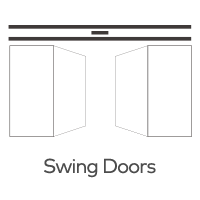What safety features are typically incorporated into automatic sliding door controller systems?
Automatic sliding doors have become a common sight in various public and private spaces, offering convenience and accessibility. Ensuring the safety of users and preventing accidents is paramount in these systems. This article explores the key safety features typically incorporated into automatic sliding door controller systems, highlighting the technology and mechanisms that make these doors reliable and secure.

1. Motion Sensors for Detection
Presence Sensors: Automatic sliding doors are equipped with motion sensors that detect the presence of individuals approaching or within the door's vicinity. These sensors ensure that doors only open when necessary, minimizing the risk of collisions.
Obstacle Detection: In addition to presence sensors, automatic sliding door systems often include obstacle detection sensors. These sensors halt door movement if an obstruction is detected, preventing injuries or damage.
2. Activation Devices
Push Buttons: Manual push buttons allow users to initiate door movement when needed. These buttons are often conveniently placed near the door and are designed for easy access.
Hand Wave Sensors: Hand wave sensors are touchless devices that trigger door opening when users wave their hand in front of the sensor. This touchless operation minimizes contact and enhances hygiene.
3. Adjustable Door Speed
Variable Speed Control: Automatic sliding door controllers typically offer adjustable door speed settings. This allows for customization to suit different environments, such as slowing down door speed in high-traffic areas for added safety.
4. Low-Energy Operation
Low-Energy Mode: Some automatic sliding door systems offer a low-energy mode. In this mode, doors operate with reduced force, minimizing the risk of injury, particularly in healthcare facilities and areas with vulnerable populations.
5. Emergency Opening and Manual Mode
Emergency Release: Automatic sliding door systems are equipped with an emergency release mechanism. In case of power failure or emergencies, this allows doors to be manually pushed open.
Manual Mode: Some systems also offer a manual mode, which enables manual operation in case of technical failures or emergencies.
6. Access Control and Security Features
Access Control Integration: Automatic sliding doors can be integrated with access control systems, limiting entry to authorized personnel. This enhances security and prevents unauthorized access.
Locking Mechanisms: Some doors are equipped with electromagnetic locks that engage when the door is closed, providing an additional layer of security.
7. Safety Standards and Compliance
Code Compliance: Manufacturers ensure that automatic sliding door systems meet relevant safety codes and standards, such as ANSI/BHMA A156.10. Compliance ensures that the systems are designed with safety in mind.
Regular Maintenance: Routine maintenance is essential to ensure that safety features remain functional. Manufacturers often provide maintenance guidelines to keep the systems in optimal condition.
Conclusion
Automatic sliding door controller systems incorporate a range of safety features to protect users and provide reliable and secure operation. Motion sensors, presence detection, obstacle detection, adjustable door speeds, low-energy modes, and emergency features are all part of these systems to minimize risks and ensure safe operation. Compliance with safety standards and regular maintenance further guarantee the safety and functionality of automatic sliding doors, making them a trusted choice for enhancing accessibility and convenience in various settings.







